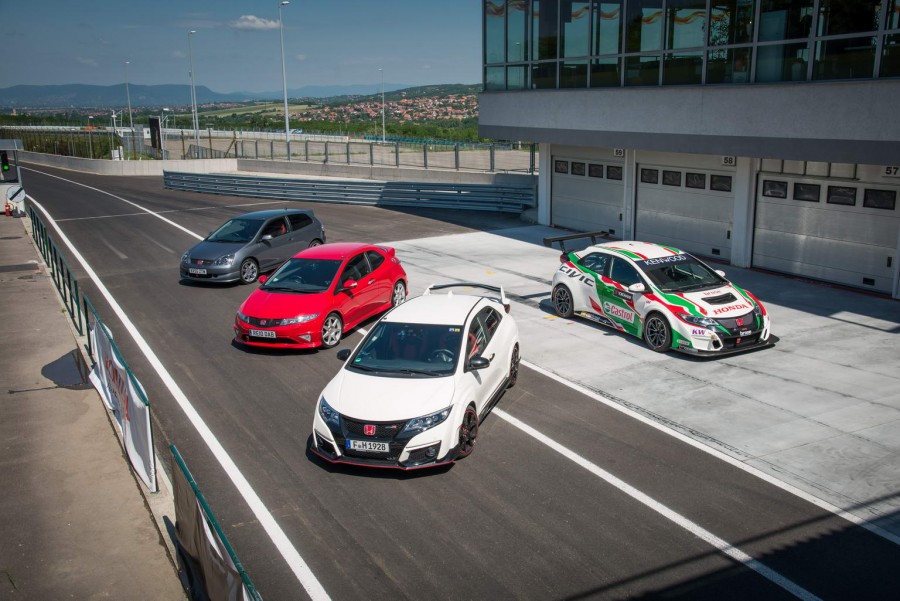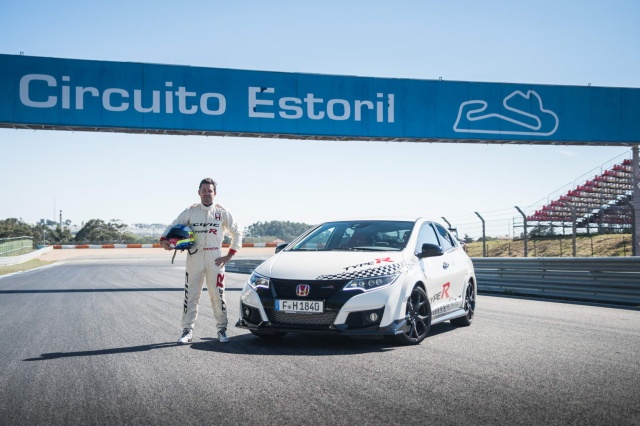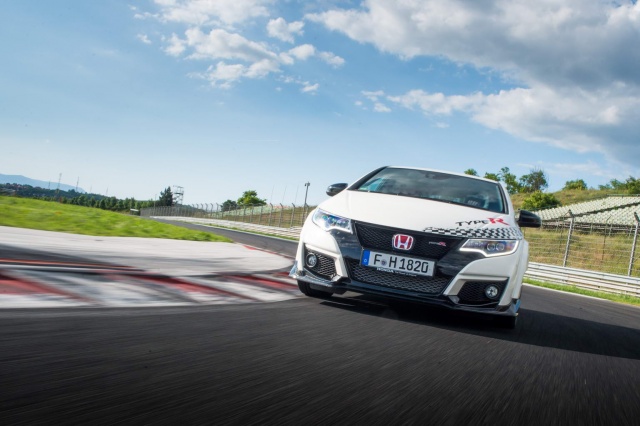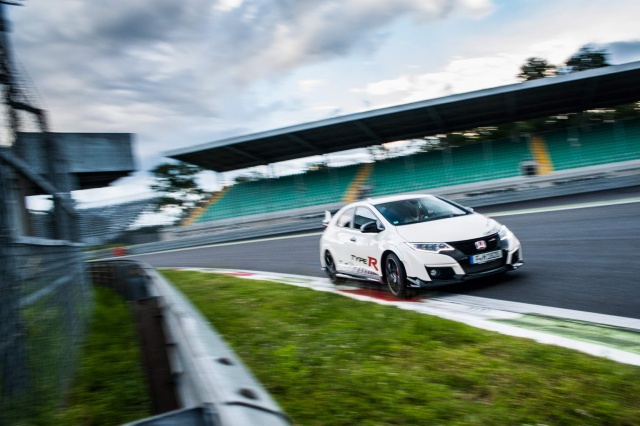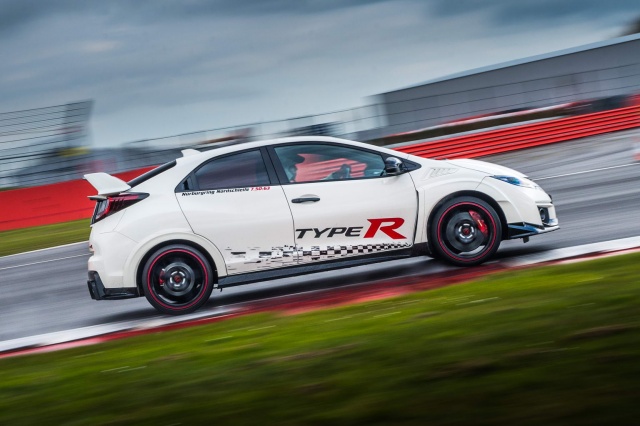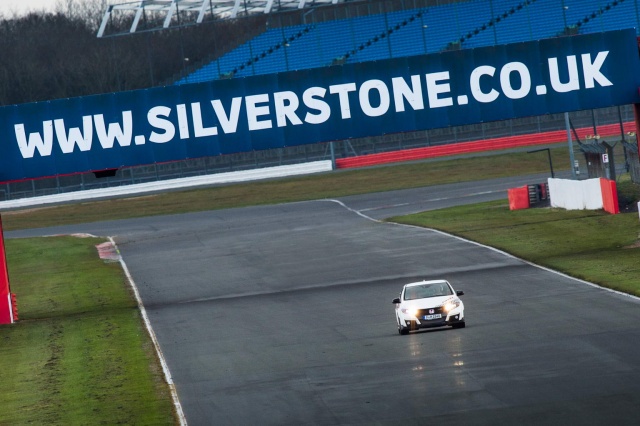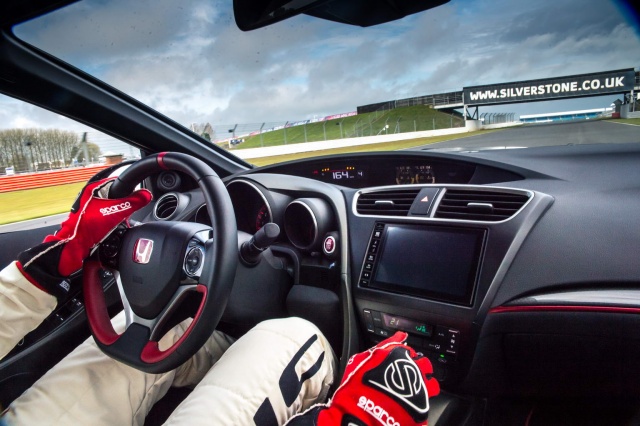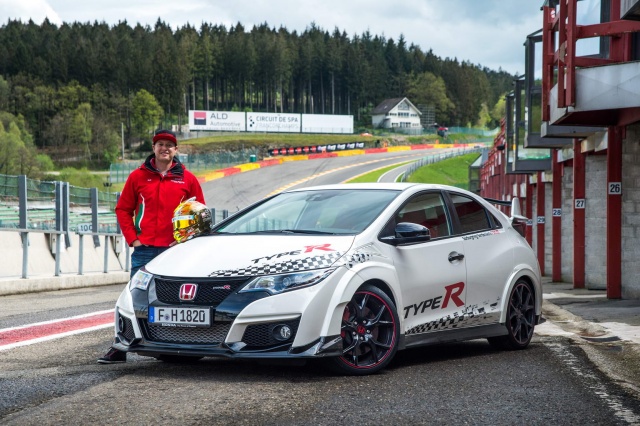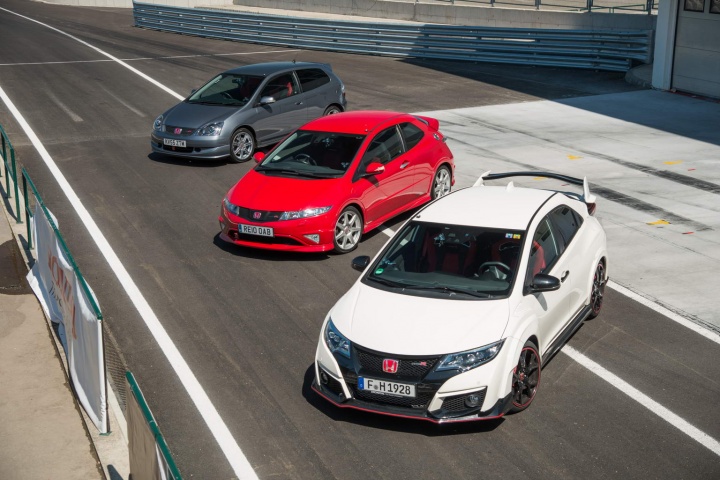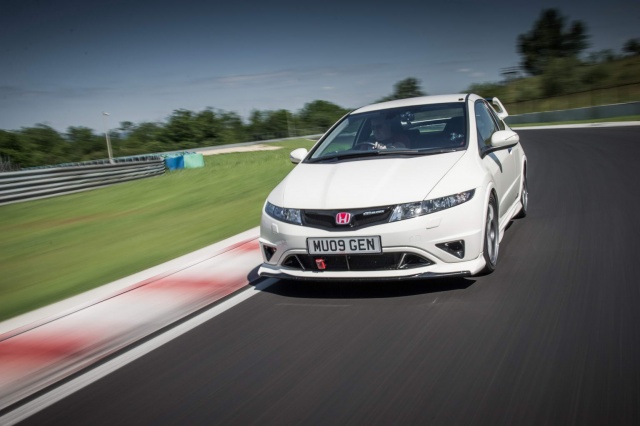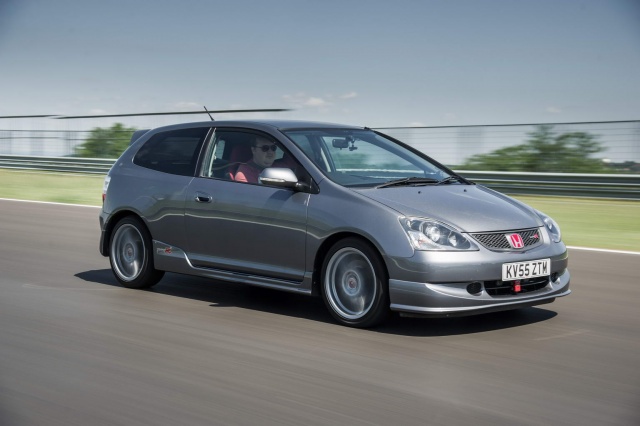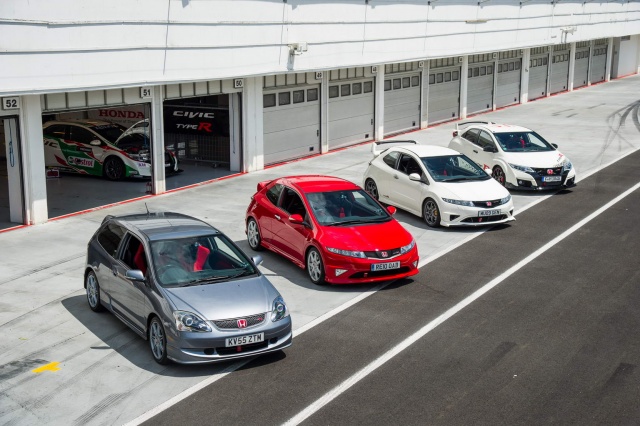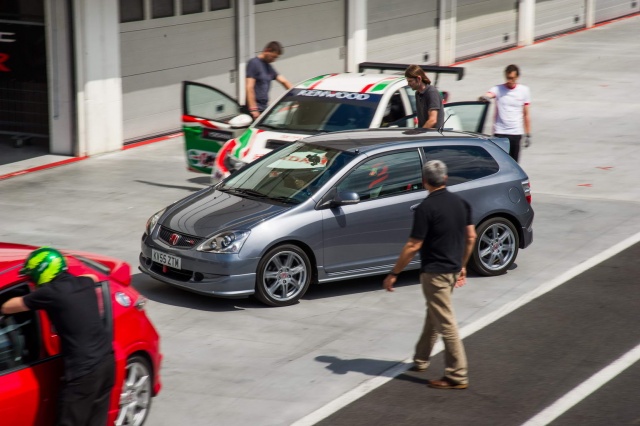Five lap records at five tracks in the Civic Type R - can Honda set a Guinness World Record?
Track work. That's the reason the latest Civic Type R (CTR) looks the way it does, according to Honda. This 310hp turbocharged hatchback's brash appearance is one of the most divisive facets of the car. Yet the Japanese company maintains every slat, vent, flared wheelarch, splitter and spoiler is genuinely necessary to keep this 270km/h machine on the deck at pace. It's why the current CTR, based on the ninth-generation Civic, managed to hold the front-wheel drive production car lap record at the Nürburgring Nordschleife... for either one year or two, depending on your viewpoint.
Honda developed the fourth iteration of its CTR with one beady eye firmly fixed on the legendary German track throughout. It wanted that front-wheel drive lap record and therefore built a car that would be capable of taking it. The hot hatch war truly kicked off when SEAT was the first to make a front-wheel drive car dip beneath the eight-minute barrier for a lap, its Leon Cupra 280 posting 7:58.44 in March 2014. Ostensibly, it was Renault Sport that hit back, its Megane 275 Trophy-R eclipsing the Cupra's time with a 7:54.36 a mere three months later.
That record stood until the Geneva Motor Show in March 2015, when Honda - unveiling the madcap turbo CTR for the first time - actually went and claimed it had got a pre-production version of its newcomer to do a ballistic 7:50.63... in May 2014, a full month before the Megane's benchmark. Renault Sport must have been fuming. And it looked like Honda had the record sewn up for the foreseeable future, because there was little on the front-wheel drive horizon that threatened to take its crown.
Until Volkswagen came up on the outside with a car no one thought would be mixing it at this level: the Golf GTI. Given the most potent Golf, the R, has 300hp and all-wheel drive, the front-wheel drive GTI has to 'make do' with either 220hp - or 230hp with the Performance Pack. Nowhere near the class elite, then, but nobody told Wolfsburg that. The Golf GTI Clubsport S, a very limited edition, stripped-out special with 310hp, stormed the Nordschleife with a 7:49.21 in April this year.
Now it's Honda's turn to simmer. The Golf's unexpected performance has clearly irked the Japanese giant, because it's already planning to go back to the 'Ring to have another go at claiming the prize. It'll be tricky for the CTR to do that, as Honda says nothing was left out on the track when setting that 7:50.63 lap, but try the company will. It's either that, or another, even faster Type R is on the way... here's hoping.
Until then, it's going to have to satisfy itself with being a world record holder instead. The record in question is for holding front-wheel drive production car lap records at five different tracks across Europe; and no, the Nürburgring is not one of them. The venues in question are Silverstone, Spa-Francorchamps, Monza, Estoril and the Hungaroring, and it's the last of these we're at, in order to see if Honda will clinch the deal. It's already bagged the necessary laps at the other circuits, in the hands of a variety of touring car stars: Matt Neal dealt with Silverstone, recording 2:31.85 on April 26th; at Spa on May 10th, Rob Huff whipped round in 2:56.91; Monza, on May 23rd, saw Hungarian driver Norbert 'Norbie' Michelisz putting in a fine 2:15.16; and then Portuguese racer Bruno Correia posted 2:04.08 on his home circuit of Estoril.
Honda reckoning on the benefits of home advantage, Norbie was handed the keys to the CTR for the final, pivotal attempt. The run took place on a baking Hungaroring on June 6th and we'll keep you in suspense for a moment, fast-forwarding instead to June 7th. It's still baking hot and Honda has decided to show us just how far the Civic Type R has come in just three generations by laying on examples of the older iterations to try back-to-back with the new boy.
We are doing this in order, which is good, so first up is the 'bread van'. The original Civic Type R was the almost mythical EK9 version, sold only in Japan in the 1990s. Powered by a jewel-like 1.6-litre VTEC engine, this thing was lightweight, shorn of needless fripperies and noisy. By today's standards, it wouldn't be considered quick, but it's highly desirable. As is the first 'official' Civic Type R that made it to our corner of the world. The 'EP3' appeared in 2001 and upped capacity to two litres, with power rated at a neat 200hp. A lot, when the contemporary Golf GTI was packing just 150hp and the Ford Focus ST had 170hp.
The example Honda has rustled up from the UK heritage fleet is a tidy, 30,000-miler in grey. It looks immaculate inside in terms of wear and tear, even if it's a bit dated visually. No matter; what's important here is the drive. What marked the EP3 out was independent rear suspension and it remains a sharp, eager car, cornering flat and seemingly bereft of understeer. All is not well, though, as there's a hesitance in the VTEC delivery around 6,000rpm, while the racing driver serving as an instructor in the passenger seat begins with a less-than-confidence inspiring lecture about its fragile brakes. That, plus our own lack of skill behind the wheel and a total unfamiliarity with the track (save for playing it on Geoff Crammond's Microprose Grand Prix circa 1991 on an Amiga 500), leads to a cautious lap time of 2:36.
Stepping from it into the FN2's futuristic cabin is a bit of a shock, because the interior of the red car feels light years ahead in terms of quality. Apart from the driver's seat - Honda never seems to allow the chair to go low enough in its hot hatches. Perched a little high, we're not expecting much of the FN2. When Honda released this UK-built car in 2006, it had less advanced torsion beam rear suspension than the EP3, plus exactly the same four-cylinder VTEC engine, blessed with enormous gains of, er... 1hp and 5Nm. In a car that was heavier than its forebear.
The aim was to make it more rounded and comfortable, which drew the ire of Type R fans who said the R stood for racing, after all, and if people wanted rounded and comfortable, they should buy a Civic i-DTEC. So the fact we're fully seven seconds quicker round the Hungaroring in the FN2 is what stuns us. There's much more understeer, pronounced body roll, steering that seems less feelsome than the EP3's rack and acceleration that doesn't feel any quicker. But it is smoother, the brakes are fine and the gearchange is epic. And once you've fathomed out how to balance the FN2 on the throttle, it proves to be much more adept than critics would have you believe, setting an enjoyable and quick 2:29.001 time in the process.
Up next is the Mugen, in many ways the precursor of today's CTR. A honking great rear wing, S2000-rivalling power of 240hp and shorter gearing combined with firmer suspension, larger front brakes with four-piston callipers and forged alloy wheels to bring a lot of focus to the Civic. It also possessed a limited-slip differential, but in markets where it was sold, it was limited in number and fearsomely expensive. Worth it, though, because it takes all the floppy bits of the FN2 Civic and throws them away, adding much of the taut precision of the EP3 to proceedings.
Regrettably, the UK heritage car - kept superbly by the Honda team - is nevertheless capable of proper supercar histrionics, and in the heat of the Hungaroring its brakes are stewing. By the time we clamber aboard, a Belgian racing driver has given them a hammering and we're having to anchor on 50- to 100 metres earlier for each corner than we were in the FN2. Despite that, the Mugen storms round in 2:27 and it makes us question just how quick it could have gone had it been in fine fettle.
And yet the step up in performance, in all departments, from the Mugen to the current turbocharged car is remarkable. Chief weapon in the FK2's armoury is torque - at 400Nm, it's more than double what either of the regular CTR predecessors had, and as much as the EP3 and the Mugen combined. It makes the current model so much quicker to exit low-speed corners and 20- to 30km/h faster at the end of the Hungaroring's main straight. We clearly don't retune to its turbocharged powers quickly enough following the naturally aspirated CTRs, because 2:23.66 is modest - as proven by another journalist in our group who registers a 2:20 with ease.
And how about Norbie? What did he clock the day before? Well, using every ounce of his racing skill and local knowledge, he hustled the Civic round in a storming time of 2:10.85, securing Honda the Guinness World Record in the process. So while the Japanese manufacturer might not (currently) hold the Nordschleife time, it's aggressively showing its hyper-hatch's prowess. Racing has obviously been in the Civic Type R's blood since the start; and it would appear lurid looks and a big turbo are absolutely perfect for track work.
Honda Civic Type R (EP3, seventh-generation Civic)
Engine: 2.0-litre four-cylinder petrol
Transmission: front-wheel drive, six-speed manual
Top speed: 235km/h
0-100km/h: 6.8 seconds
Power: 200hp at 7,400rpm
Torque: 188Nm at 5,900rpm
Honda Civic Type R (FN2, eighth-generation Civic)
Engine: 2.0-litre four-cylinder petrol
Transmission: front-wheel drive, six-speed manual
Top speed: 235km/h
0-100km/h: 6.8 seconds
Power: 201hp at 7,800rpm
Torque: 193Nm at 5,600rpm
Honda Civic Type R Mugen (FN2, eighth-generation Civic)
Engine: 2.0-litre four-cylinder petrol
Transmission: front-wheel drive, six-speed manual
Top speed: 240km/h
0-100km/h: 6.0 seconds
Power: 240hp at 8,300rpm
Torque: 213Nm at 6,250rpm
Honda Civic Type R (FK2, ninth-generation Civic)
Engine: 2.0-litre turbocharged four-cylinder petrol
Transmission: front-wheel drive, six-speed manual
Top speed: 270km/h
0-100km/h: 5.7 seconds
Power: 310hp at 6,500rpm
Torque: 400Nm at 2,500rpm

